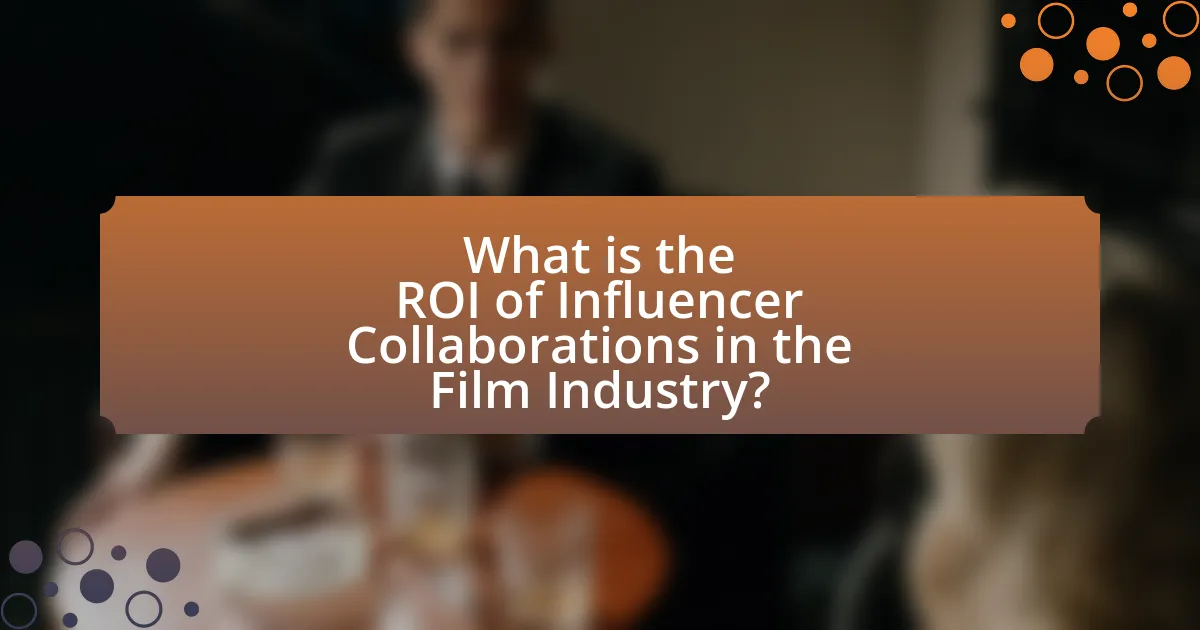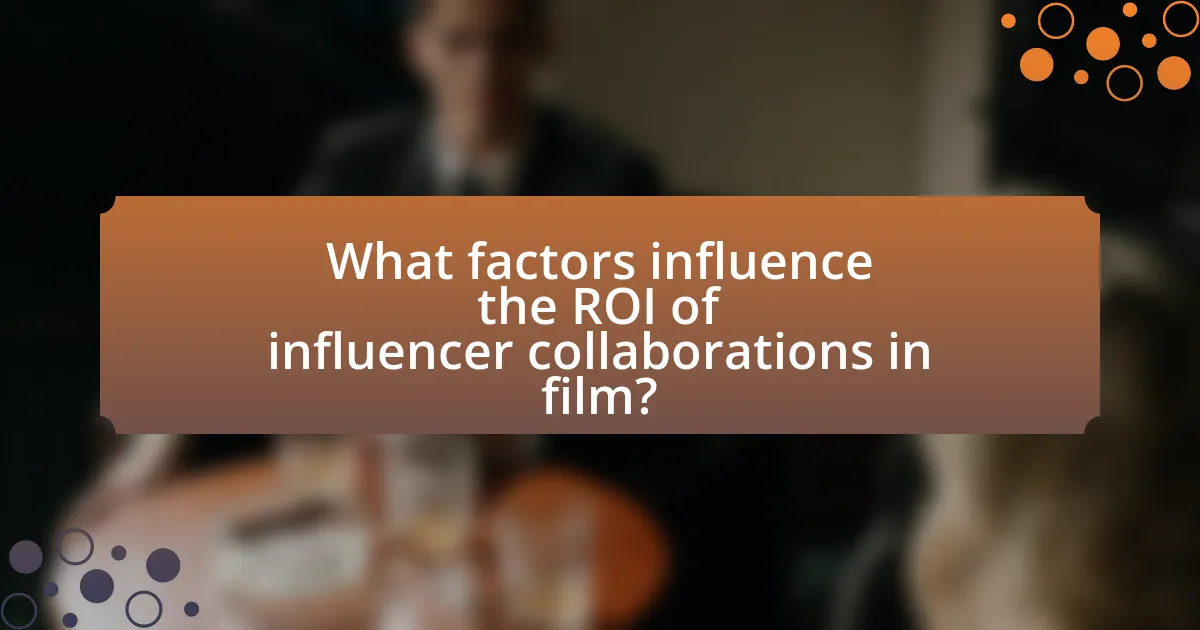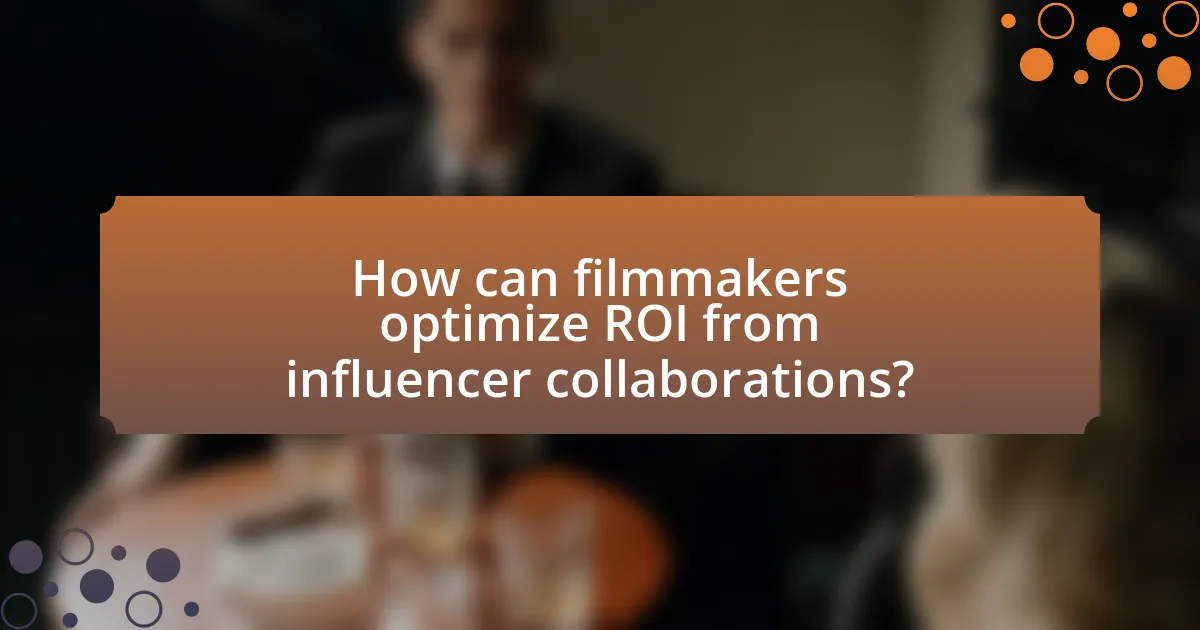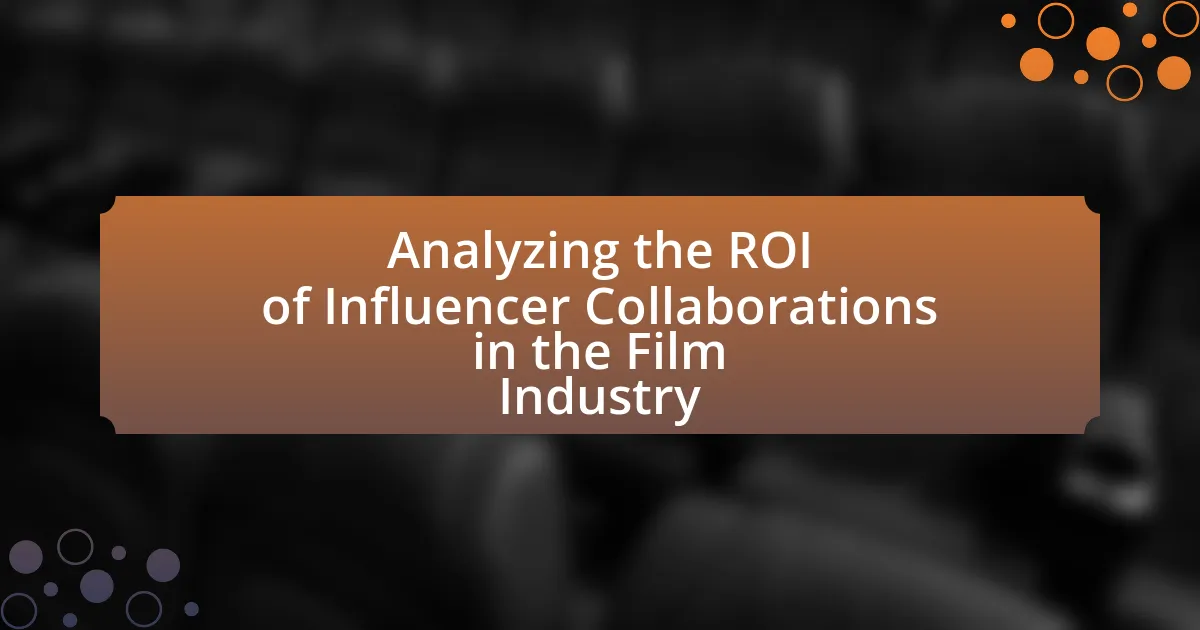The article analyzes the return on investment (ROI) of influencer collaborations in the film industry, highlighting that such partnerships can yield returns of up to $6.50 for every dollar spent. It defines ROI in this context as the measurable value generated from influencer partnerships, emphasizing key metrics such as engagement rates, reach, and conversion rates. The article discusses the importance of audience alignment, content quality, and strategic influencer selection in maximizing ROI, while also exploring effective collaboration formats and future trends in influencer marketing within the film sector. Additionally, it addresses common pitfalls filmmakers should avoid to enhance the effectiveness of their influencer campaigns.

What is the ROI of Influencer Collaborations in the Film Industry?
The ROI of influencer collaborations in the film industry can be substantial, often yielding returns of up to $6.50 for every dollar spent. This high ROI is attributed to influencers’ ability to reach targeted audiences effectively, driving ticket sales and increasing brand awareness. For instance, a study by the Influencer Marketing Hub found that 63% of marketers believe influencer collaborations enhance brand visibility, which directly correlates with increased audience engagement and box office performance. Additionally, films that leverage influencer partnerships often see a significant boost in social media buzz, further amplifying their reach and potential revenue.
How is ROI defined in the context of influencer collaborations?
ROI, or Return on Investment, in the context of influencer collaborations is defined as the measurable value generated from the partnership relative to the costs incurred. This value can be quantified through various metrics such as increased brand awareness, engagement rates, and ultimately, sales conversions attributed to the influencer’s promotion. For instance, a study by Influencer Marketing Hub indicates that businesses earn an average of $5.78 for every dollar spent on influencer marketing, demonstrating a clear financial return.
What metrics are used to measure ROI in influencer marketing?
The primary metrics used to measure ROI in influencer marketing include engagement rate, reach, impressions, conversion rate, and cost per acquisition. Engagement rate quantifies interactions (likes, comments, shares) relative to follower count, indicating audience interest. Reach measures the total number of unique users who see the content, while impressions count the total views, providing insight into visibility. Conversion rate tracks the percentage of users who take a desired action, such as making a purchase, after engaging with the influencer’s content. Cost per acquisition calculates the total cost of the campaign divided by the number of conversions, helping assess financial efficiency. These metrics collectively provide a comprehensive view of the effectiveness and financial return of influencer marketing efforts.
How do these metrics apply specifically to the film industry?
Metrics such as engagement rates, reach, and conversion rates are crucial in the film industry to evaluate the effectiveness of influencer collaborations. Engagement rates indicate how well an influencer’s audience interacts with promotional content, which can directly impact a film’s visibility and audience interest. For instance, a study by the Influencer Marketing Hub found that campaigns with higher engagement rates often lead to increased ticket sales and streaming views. Reach measures the total number of unique viewers exposed to the film’s promotional content, helping filmmakers understand the potential audience size. Conversion rates track the percentage of viewers who take action, such as purchasing tickets or streaming the film, providing a clear indicator of the collaboration’s financial return. These metrics collectively enable film marketers to assess the success of influencer partnerships and optimize future campaigns for better ROI.
Why are influencer collaborations important for films?
Influencer collaborations are important for films because they significantly enhance audience reach and engagement. By leveraging the established trust and large followings of influencers, films can tap into niche markets and demographics that traditional marketing may overlook. For instance, a study by the Influencer Marketing Hub found that 49% of consumers depend on influencer recommendations when making purchase decisions, indicating that influencers can effectively drive ticket sales and viewership. Additionally, collaborations often generate authentic content that resonates with audiences, leading to increased social media buzz and word-of-mouth promotion, which are crucial for a film’s success in a competitive market.
What role do influencers play in film marketing strategies?
Influencers play a crucial role in film marketing strategies by leveraging their established audiences to create buzz and drive engagement for film releases. Their ability to reach targeted demographics allows filmmakers to promote films effectively, often resulting in increased ticket sales and social media engagement. For instance, a study by the Influencer Marketing Hub found that 49% of consumers depend on influencer recommendations when making purchase decisions, highlighting the significant impact influencers have on audience behavior. Additionally, collaborations with influencers can enhance a film’s visibility and credibility, as their endorsements often resonate more authentically with fans compared to traditional advertising methods.
How can influencer collaborations enhance audience engagement?
Influencer collaborations enhance audience engagement by leveraging the influencer’s established trust and connection with their followers. This relationship allows brands to reach a more targeted audience, as influencers often have niche followings that align with specific demographics. According to a study by the Digital Marketing Institute, 49% of consumers depend on influencer recommendations, indicating that these collaborations can significantly increase brand visibility and interaction. Furthermore, influencer content often generates higher engagement rates, with posts receiving 10 times more engagement than traditional brand posts, as reported by a study from the influencer marketing platform, Influencity. This heightened engagement can lead to increased brand loyalty and conversion rates, demonstrating the effectiveness of influencer partnerships in driving audience interaction.

What factors influence the ROI of influencer collaborations in film?
The ROI of influencer collaborations in film is influenced by factors such as audience alignment, engagement rates, content quality, and campaign objectives. Audience alignment ensures that the influencer’s followers match the film’s target demographic, which increases the likelihood of reaching potential viewers. Engagement rates, measured through likes, shares, and comments, indicate how effectively the influencer can generate interest and conversation around the film. High-quality content produced by the influencer can enhance the film’s image and appeal, leading to greater viewer interest. Lastly, clearly defined campaign objectives, such as ticket sales or social media buzz, help in measuring the success of the collaboration and its impact on ROI.
How does the choice of influencer affect ROI?
The choice of influencer significantly affects ROI by determining the effectiveness of audience engagement and conversion rates. Influencers with a strong alignment to the film’s target demographic can drive higher engagement, leading to increased ticket sales and merchandise purchases. For instance, a study by Influencer Marketing Hub found that businesses earn an average of $5.78 for every dollar spent on influencer marketing, highlighting the financial impact of selecting the right influencer. Additionally, influencers with authentic connections to their followers can enhance brand credibility, further boosting ROI through increased consumer trust and loyalty.
What criteria should be considered when selecting influencers?
When selecting influencers, key criteria include audience alignment, engagement rates, authenticity, and content quality. Audience alignment ensures that the influencer’s followers match the target demographic of the film, which is crucial for effective marketing. Engagement rates, measured by likes, comments, and shares, indicate how actively the influencer’s audience interacts with their content, reflecting potential reach and impact. Authenticity is vital, as influencers who genuinely connect with their audience foster trust, leading to higher conversion rates. Lastly, content quality, including aesthetics and relevance to the film’s themes, influences the overall effectiveness of the collaboration. These criteria collectively enhance the likelihood of a successful influencer partnership in the film industry.
How does an influencer’s audience demographics impact ROI?
An influencer’s audience demographics significantly impact ROI by determining the relevance and engagement level of the influencer’s followers with the brand’s target market. When an influencer’s audience aligns closely with the brand’s desired customer profile, the likelihood of conversions increases, leading to a higher return on investment. For instance, a study by Influencer Marketing Hub found that campaigns targeting specific demographics can yield up to 11 times higher ROI compared to those with a mismatched audience. This correlation underscores the importance of analyzing audience age, gender, location, and interests to optimize marketing strategies and maximize financial returns in influencer collaborations within the film industry.
What types of collaborations yield the highest ROI?
Collaborations that yield the highest ROI in the film industry typically involve partnerships with influencers who have a strong, engaged following and align closely with the film’s target audience. For instance, studies show that influencer marketing can generate up to 11 times the ROI of traditional advertising methods, particularly when influencers create authentic content that resonates with their followers. Additionally, collaborations that include exclusive content, behind-the-scenes access, or interactive experiences tend to drive higher engagement and ticket sales, as evidenced by campaigns for films like “Deadpool,” which utilized influencer partnerships effectively to boost visibility and revenue.
What are the most effective formats for influencer collaborations in film?
The most effective formats for influencer collaborations in film include sponsored content, social media takeovers, and behind-the-scenes access. Sponsored content allows influencers to create posts that promote the film, leveraging their audience to drive interest and ticket sales. Social media takeovers enable influencers to engage directly with the film’s audience, providing a personal touch and fostering community interaction. Behind-the-scenes access offers exclusive content that can generate buzz and excitement, as fans appreciate insider perspectives. Research indicates that campaigns utilizing these formats can yield higher engagement rates, with sponsored posts achieving an average engagement rate of 1.9% compared to traditional advertising methods.
How do different collaboration strategies compare in terms of ROI?
Different collaboration strategies in influencer marketing yield varying ROI, with data indicating that partnerships with micro-influencers often deliver higher returns compared to macro-influencers. A study by the Digital Marketing Institute found that micro-influencers, who typically have between 1,000 to 100,000 followers, generate engagement rates of 7% to 10%, while macro-influencers, with over 100,000 followers, average around 1% to 3%. This higher engagement translates to better conversion rates and ultimately a more favorable ROI for campaigns in the film industry. Additionally, collaborations that focus on authentic storytelling and niche audiences tend to outperform generic promotional strategies, further enhancing ROI metrics.

How can filmmakers optimize ROI from influencer collaborations?
Filmmakers can optimize ROI from influencer collaborations by strategically selecting influencers whose audience aligns with their target demographic. This alignment ensures that promotional content reaches potential viewers effectively, increasing engagement and ticket sales. For instance, a study by Influencer Marketing Hub found that businesses earn an average of $5.78 for every dollar spent on influencer marketing, highlighting the financial benefits of targeted collaborations. Additionally, filmmakers should establish clear objectives and measurable KPIs, such as engagement rates and conversion metrics, to assess the effectiveness of each collaboration. By analyzing these metrics, filmmakers can refine their strategies and focus on partnerships that yield the highest returns.
What best practices should filmmakers follow when engaging influencers?
Filmmakers should prioritize authenticity and alignment with influencers when engaging them for collaborations. Authenticity ensures that the influencer’s audience perceives the partnership as genuine, which can enhance engagement and trust. For instance, a study by the Digital Marketing Institute found that 61% of consumers trust influencer recommendations over brand advertisements. Additionally, filmmakers should select influencers whose values and audience demographics align with their film’s target market, as this increases the likelihood of reaching potential viewers effectively. Engaging influencers with a proven track record in relevant genres can also amplify the film’s visibility and credibility, leading to a higher return on investment.
How can filmmakers measure the effectiveness of their influencer campaigns?
Filmmakers can measure the effectiveness of their influencer campaigns by analyzing key performance indicators (KPIs) such as engagement rates, reach, and conversion metrics. Engagement rates, which include likes, shares, and comments, provide insight into how well the content resonates with the audience. Reach indicates the total number of unique viewers exposed to the campaign, while conversion metrics track actions taken by viewers, such as ticket purchases or website visits, directly linked to the influencer’s promotion. According to a study by Influencer Marketing Hub, campaigns that utilize influencers can yield an average return on investment of $5.78 for every dollar spent, highlighting the potential financial impact of effective influencer collaborations.
What tools are available for tracking influencer collaboration performance?
Tools available for tracking influencer collaboration performance include platforms like HypeAuditor, Traackr, and Sprout Social. HypeAuditor provides analytics on influencer authenticity and audience demographics, enabling brands to assess the effectiveness of their collaborations. Traackr offers comprehensive tracking of influencer campaigns, measuring engagement and reach across multiple channels. Sprout Social allows brands to analyze social media performance metrics, providing insights into audience interaction and campaign success. These tools collectively enhance the ability to evaluate the return on investment (ROI) from influencer partnerships in the film industry.
What common pitfalls should filmmakers avoid in influencer collaborations?
Filmmakers should avoid misalignment of brand values in influencer collaborations. When the values of the filmmaker’s project do not resonate with the influencer’s audience, it can lead to ineffective marketing and a negative perception of the film. For instance, a study by Influencer Marketing Hub indicates that 63% of consumers trust influencers more than brands, highlighting the importance of authenticity in partnerships. Additionally, filmmakers should steer clear of inadequate communication regarding expectations, as unclear roles can result in unsatisfactory outcomes and wasted resources.
How can misalignment between influencers and film projects affect ROI?
Misalignment between influencers and film projects can significantly reduce ROI by failing to engage the target audience effectively. When influencers do not resonate with the film’s themes or target demographic, their promotional efforts may not translate into ticket sales or viewership. For instance, a study by Influencer Marketing Hub found that campaigns with aligned influencer partnerships can yield up to 11 times higher ROI compared to misaligned collaborations. This indicates that the right influencer can drive audience interest and conversion, while misalignment can lead to wasted marketing resources and diminished returns.
What are the risks of relying too heavily on influencer marketing?
Relying too heavily on influencer marketing poses several risks, including potential damage to brand reputation, lack of authenticity, and fluctuating audience engagement. Brands may face backlash if influencers engage in controversial behavior, which can lead to negative perceptions among consumers. Additionally, influencers may not always align with the brand’s values, resulting in a disconnect that can undermine the authenticity of the marketing message. Furthermore, audience engagement can be unpredictable; as trends shift, influencers may lose relevance, leading to diminishing returns on marketing investments. According to a 2021 survey by the Digital Marketing Institute, 61% of marketers reported that influencer partnerships can backfire if not carefully managed, highlighting the importance of strategic alignment and risk assessment in influencer collaborations.
What are the future trends in influencer collaborations within the film industry?
Future trends in influencer collaborations within the film industry include increased integration of influencers in marketing campaigns, a focus on authenticity, and the use of data analytics to measure engagement and ROI. As the film industry evolves, influencers are becoming key partners in promoting films through social media platforms, leveraging their established audiences to create buzz and drive ticket sales. For instance, a study by the Influencer Marketing Hub in 2022 indicated that 63% of marketers planned to increase their influencer marketing budgets, highlighting the growing recognition of influencers’ impact on consumer behavior. Additionally, collaborations are shifting towards long-term partnerships rather than one-off promotions, allowing for deeper storytelling and audience connection. This trend is supported by the fact that films featuring influencer collaborations often see higher engagement rates, as evidenced by the success of films like “To All the Boys I’ve Loved Before,” which utilized influencer marketing strategies effectively.
How is technology changing the landscape of influencer marketing in film?
Technology is transforming influencer marketing in film by enabling more precise targeting and measurement of campaign effectiveness. Advanced analytics tools allow filmmakers and marketers to track engagement metrics, audience demographics, and conversion rates in real-time, leading to data-driven decisions that enhance return on investment (ROI). For instance, platforms like Instagram and TikTok provide insights into viewer interactions, helping brands identify which influencers resonate most with their target audience. Additionally, the rise of artificial intelligence and machine learning algorithms facilitates personalized content recommendations, optimizing influencer partnerships for better audience engagement. This shift towards data-centric strategies is evidenced by a 2022 report from Influencer Marketing Hub, which found that 63% of marketers believe technology has significantly improved their ability to measure campaign success in the film industry.
What emerging platforms should filmmakers consider for influencer collaborations?
Filmmakers should consider platforms like TikTok, Clubhouse, and Twitch for influencer collaborations. TikTok’s rapid growth and short-form video format allow filmmakers to engage younger audiences effectively, with over 1 billion active users as of 2023. Clubhouse offers a unique audio experience for real-time discussions, enabling filmmakers to connect with influencers in a more personal setting, while Twitch, primarily known for gaming, has expanded to include various content types, allowing filmmakers to tap into a dedicated community of viewers. These platforms provide innovative ways to reach diverse audiences and enhance marketing strategies in the film industry.
What practical tips can filmmakers implement to enhance ROI from influencer collaborations?
Filmmakers can enhance ROI from influencer collaborations by selecting influencers whose audience aligns closely with their target demographic. This alignment ensures that promotional content reaches potential viewers who are more likely to engage with the film. Additionally, filmmakers should establish clear objectives and measurable KPIs for the collaboration, such as tracking engagement rates, ticket sales, or social media reach, to assess the effectiveness of the partnership.
Furthermore, leveraging data analytics tools can provide insights into audience behavior and preferences, allowing filmmakers to tailor their campaigns more effectively. According to a study by Influencer Marketing Hub, businesses earn an average of $5.78 for every dollar spent on influencer marketing, highlighting the potential financial benefits of strategic collaborations. By focusing on these practical tips, filmmakers can maximize the return on their investments in influencer partnerships.
